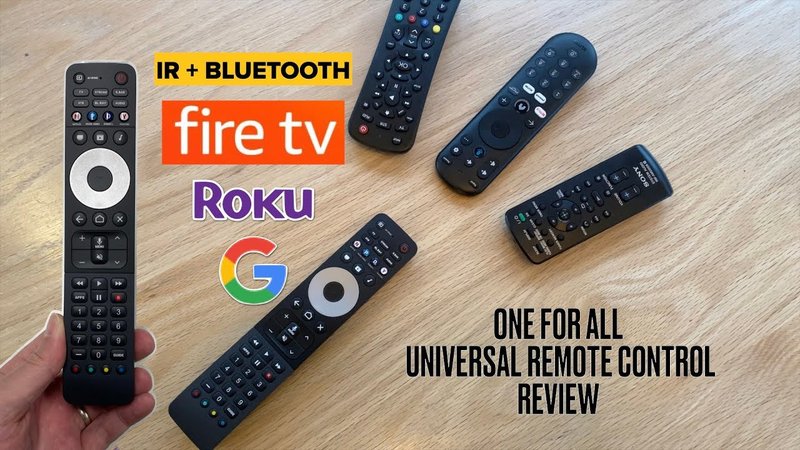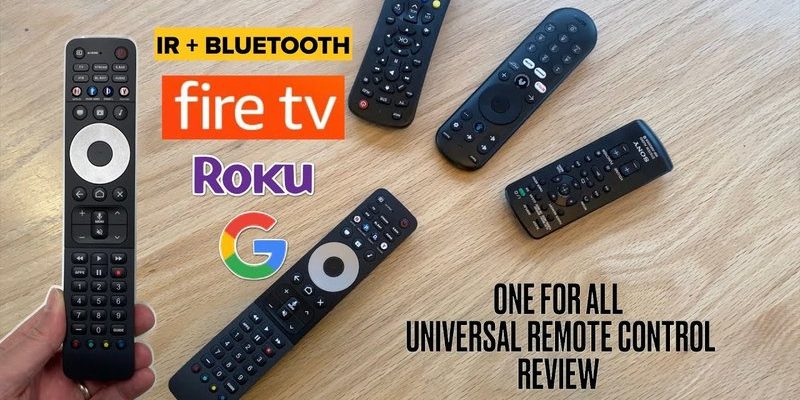
Okay, so here’s the thing—One For All is a pretty well-known brand in the world of universal remotes. They’re right up there with Logitech Harmony and GE. If you’ve ever stood in the electronics aisle at Target scratching your head, you’ve probably seen them. Their remotes claim to be able to control just about any device in your living room. But when it comes to streaming gadgets, things can get a little tricky. Let’s break it down together, step by step, so you’ll know if swapping out your pile of remotes for a single One For All remote is actually going to make your life easier…or just more confusing.
How Universal Remotes (Like One For All) Work in Plain English
First off, let’s get a grip on what a universal remote actually does. Think of it like a translator at the United Nations, but for electronics. Instead of learning every language yourself (or, in this case, every remote), you have one device that can “speak” to all your gear by sending the right signals. One For All remotes come preloaded with thousands of device codes, which is pretty cool.
You pop in the right code (or sometimes enter an auto-search mode) and—if all goes well—the universal remote is now able to send commands to your TV, sound system, or streaming box. You can usually set it up by aiming it at the device, holding down a few buttons, and watching for that flash of light or a beep that tells you it worked. Sounds simple, but—honestly—it can be hit or miss, especially with streaming devices.
Here’s the curveball: traditional devices like TVs and DVD players have been around for decades, and their remote codes hardly change. Streaming devices? They’re newer, often use different technology (like Bluetooth, Wi-Fi, or “point-anywhere” signals), and may not play nice with old-school infra-red (IR) signals, which is the bread and butter of most universal remotes.
So, while universal remotes like One For All absolutely can control a lot of things, streaming gadgets sometimes require extra steps, or they might not work at all depending on the specific model you own.
Which Streaming Devices Can One For All Universal Remotes Control?
Let’s talk specifics. Not all streaming devices are built the same. Some play well with universal remotes, while others are stubborn. Here’s a little reality check:
- Roku (box versions): Many One For All remote models can handle older or box-style Roku players, but most Roku Streaming Sticks use Wi-Fi Direct instead of IR. That means a standard One For All remote can’t “see” them, unless your streaming device still has an IR receiver.
- Amazon Fire TV/Fire Stick: Fire TV Sticks are even trickier because they mostly rely on Bluetooth. Unless you have a Fire TV box with an IR sensor (which is rare), the universal remote won’t work. Some advanced One For All models include Bluetooth support, but you’ll want to double-check the specs before buying.
- Apple TV: Some Apple TV boxes (older generations with IR receivers) can be controlled with a universal remote, including supported One For All models. Newer ones? Not so much, since they use Bluetooth for their fancy remotes.
- Chromecast and Google TV: Universal remotes don’t work at all here, since these streaming sticks don’t have IR sensors. You’re locked into their dedicated remotes or phone apps.
I learned this the hard way after an hour of “pairing” a One For All remote with my roommate’s Roku Stick, only to realize it was never going to work—like trying to open a car with the wrong key. It’s all about the tech under the hood: if your streaming device has an IR receiver, you’re probably good. If not, the One For All remote might just take up space in your junk drawer.
How to Pair a One For All Universal Remote with a Streaming Device
If you’ve got a compatible streaming box (like a classic Roku or older Apple TV), pairing your One For All remote can be surprisingly straightforward. Here’s a step-by-step look that shouldn’t sound like it’s written by a robot:
- Install fresh batteries in your remote. Trust me, nothing’s more annoying than troubleshooting for 30 minutes only to discover your batteries are dead.
- Find your device code. The remote comes with a code booklet, or you can look it up online. Make sure you get the right code—there’s probably more than one for Roku or Apple TV, so don’t be afraid to try a few.
- Hold the setup button (or the device button) until a light blinks. Enter the code you found. If the remote blinks or your streaming box reacts, you’re in business.
- Test the controls. Try basic functions like power, volume, and navigation. If something doesn’t work, repeat the process with a different code or try the automatic search option.
Don’t be surprised if not every button works. Sometimes only the basics—like navigation and OK—are supported. If you want to program fancy extras (like quick app launch), you’ll probably have to stick with the original remote or a higher-end smart remote.
Common Troubleshooting Tips and Real-World Problems
Honestly, if everything worked perfectly the first time, I’d suspect we were living in a simulation. Here’s what most people run into when syncing a One For All universal remote to a streaming box:
- Remote not responding? Double-check the batteries (seriously, new ones). Make sure the device is plugged in and not stuck in a weird state (sometimes unplugging it helps—classic IT advice, but it works).
- Device not recognizing the remote? You might be using the wrong code. Try every code for your streaming device brand, not just the first one you see.
- Certain buttons don’t work? This is super common. Not every universal remote code supports all the little features (like fast forward, rewind, or special menus). Sometimes you just have to accept limited control, or consider programming “learning” remotes that let you copy signals from the original remote.
- Nothing at all is working? Your streaming stick might not have an IR receiver. Time to double-check your model—search Google for “[your device name] IR support” before you give up.
If you ever get really stuck, the best sanity-saving move: reset your remote to factory settings and start from scratch. Yes, it’s annoying. No, it doesn’t mean you failed. These things can be finicky!
Universal Remotes vs. Brand-Specific Streaming Remotes: What’s Better?
So, why not just stick with the remote that came in the box? That’s a fair question—and sometimes, honestly, it’s the right choice.
Brand-specific streaming remotes are designed to control just one device, but they do it perfectly. They offer all the quick-access buttons, voice controls, and extras (like headphone jacks or volume controls). If you lose yours, you can usually pick up a replacement for a little more cash.
On the flip side, universal remotes like One For All are all about cutting clutter. If you’re running a classic entertainment setup—old TV, cable box, a soundbar, and a basic streaming box—having everything on one remote really is awesome. But when you’re living in the land of modern streaming sticks and voice assistants, universal remotes sometimes feel like that friend who tries their best but just can’t keep up at trivia night.
There’s also a middle ground: higher-end universal remotes (like the big Logitech Harmony series or One For All’s most advanced models) may support Bluetooth or Wi-Fi pairing. They cost more, but they do a better job bridging the gap.
Battery Life, Syncing Issues, and the Reality of Daily Use
Let’s be real: battery life matters. All that syncing, searching for codes, and switching between devices—if you’re using a universal remote heavily, you’ll be changing batteries more often than you might like.
One For All remotes are generally pretty efficient, but streaming devices (especially ones that use Bluetooth or Wi-Fi) tend to drain the remote faster when advanced features are in use. Plus, the more times you have to reset and re-sync because something’s not working, the more you’ll get to know your battery drawer.
I keep a little cup of spare batteries on my coffee table for nights when a remote dies mid-movie. Highly recommend—it’ll spare you from fumbling in the dark.
Syncing issues also pop up when you add or remove devices. If you swap out your streaming stick, you’ll likely need to reset or reprogram the remote. And if you let the batteries die for too long, you might lose your customized settings and have to start over again. It’s not the end of the world, but it’s…well, not “plug and play,” either.
Alternatives: Smart Remotes, Phone Apps, and Voice Control
If reading this makes you think, “Hmm, maybe I want something smarter,” you’re not alone. The world of remotes has gotten wild lately.
- Smart remote systems: Devices like Logitech Harmony or some One For All “Smart Control” models connect with both IR and Bluetooth/Wi-Fi. They’re more expensive, but can control modern streaming sticks by mimicking the way the original remote works.
- Phone/tablet apps: Most streaming devices have free apps that turn your phone into a remote. It won’t help with old-school TVs or soundbars, but it’s handy if your streaming remote walks off.
- Voice assistants: Most new streaming hardware supports Alexa, Google Assistant, or Siri commands. You can ask your smart speaker to “turn on the TV” or “play Stranger Things,” and—if everything’s synced—magically, it works.
Some people (me included) end up using a weird hybrid: brand remote for streaming, universal for everything else, and the phone app as a backup. It’s not perfect, but it saves some headaches.
The Verdict: Are One For All Universal Remotes Good for Streaming Control?
So, after all this, where do we land? Can One For All universal remotes control streaming devices? Sometimes! If your streaming box still has an IR receiver, odds are good. If it’s a tiny stick that only talks via Bluetooth or Wi-Fi, you’ll need a more advanced remote or stick with the original.
One For All remotes are great for cutting remote clutter, especially if you’re running a traditional entertainment setup. But as more streaming gadgets go “wireless” and skip IR, these remotes can feel a little left behind. For mostly-TV setups with a mix of classic and modern gear, they’re a good bet. For hardcore streamers, check your device compatibility list carefully—otherwise, you might be out of luck.
If you ever get stuck, customer support lines and online forums are packed with people who’ve fought these same battles. You’re not alone—and if you finally get all your devices synced up, celebrate with a movie night. You’ve definitely earned it.
